3 Keys to Long-Term Google Ads Success (With Data!)
David Steiner
Director of Paid Ads, Oozle Media
View the Slides
Read the Transcript
Thanks Chris. As everyone or as Chris mentioned, my name’s Dave. I’m the Director of the Paid Ads team at Oozle Media and as mentioned, I do have a seven month old at home who I think is in the middle of a regression, a sleep regression. So, if you know what that’s like, yeah, like Chris said, pray for me. I’ve been with Oozle for several years now.
I’ve specialized in running PPC ads on Google for beauty schools in that time, so I’ve got a bit of experience about what works on that platform, in this industry and hopefully today I can share with you some of that knowledge.
The goal today is to hopefully shift or maybe broaden your perspective on what a PPC campaign or that part of your strategy can look like, particularly over the long term.
We’re going to look at a few case studies or success stories of some Oozle Media clients and talk about what that looks like in the long term.
Why Are Paid Ads Important?
A lot of times, and Chris mentioned this just a second ago, PPC is referred to as kind of the, we call it the “rocket fuel” sometimes, the catalyst to your marketing strategy because it can bring leads in or generate rate leads right away and this is true. I stand by that still. In fact, this slide shows a screenshot from my presentation last year in which I talked about that a little bit. I’m sure you could still find that online and watch it if you wanted to.
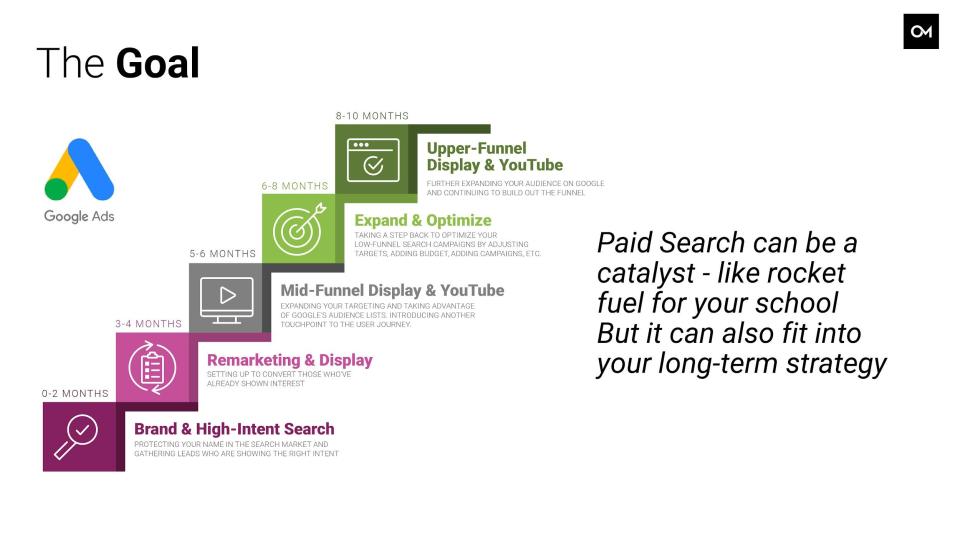
But like I said, we’re going to look at today how it can make sense as part of a long term strategy and how you can find continuous optimizations or improvement on those campaigns. Oozle has been running PPC ads for beauty schools for nearly a decade now, and we take a lot of pride in the data that we track and the reports that we provide to our clients. We present leads to our clients as names with email addresses. They’re not just numbers, they’re real people that you can verifiably attribute to your paid ads and it’s these reports that give us a really clear understanding of what’s happening with these schools, but it’s also how I pulled the data for what we’re going to go through today.
Then after going through all those numbers, we’re going to talk about what I think are the common things that these schools share to be able to achieve what they did.
So when we are looking at the data, this is what we’re going to go through and we’re going to look at five different schools. Between those five schools they’ll have a variety of locations so some will have up to five locations, some will have just one and then they’re going to have a variety of budgets as well.
So, hopefully this is a good, broad smattering of examples that you and your school can compare to. Then we’re going to look at every, the data that’s going back as far as 2018. With how quickly things have been changing over the last few years it seems like going back that far, it paints the most relevant story or picture for today’s environment. The landscape has changed a lot, but going back even three years, I think is a long time in the agency world.
Leads and Cost Per Lead for Client One
So, yeah, and then when we go through these we’re going to be looking specifically at leads and cost per lead. Let’s go ahead and look at the first one here. This is a single location school with a fairly modest budget. So just under $4,000 on average per month. We’re looking at monthly averages here over the years. We can see here on the graph, the red line represents the number of leads and the blue bars represent the cost per lead.
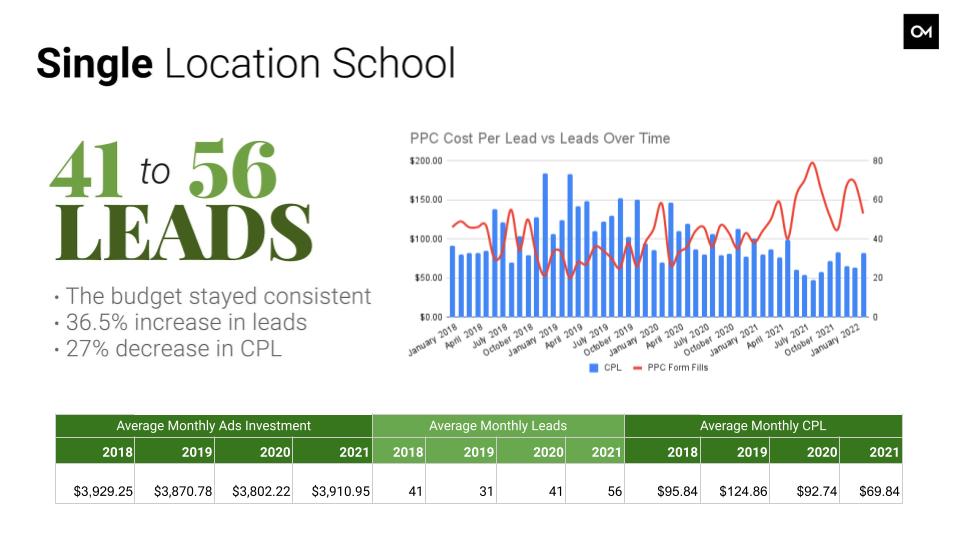
Like I said, their budgets stayed relatively the same across this timeframe, but you can see that their number of leads increased by 36.5%, which means that their cost per lead decreased on average by 27%. So, how did they achieve this success? Well, as we looked into it, they were the recipients of a lot of ad testing over many, many months or years in this case even.
Each time we did an ad test, we would run plenty of data to show which ads are performing better, which ads are performing worse, getting rid of the worst ones, iterating on the better ads. They also got a lot of attention to keyword performance. Overall account structure even was adjusted when it seemed like changes there would make improvements. They also maintain consistent communication with us and work together on their goals.
I like this graph in particular because it shows some of the variability, some of the seasonality that you can see. Not every month is better than the previous month, but if you can use your imagination to paint the trend line over this, you can see the improvement. It’s pretty clear. It’s also important to note, I think, that if you look at the difference between 2018 and 2019, the average number of leads actually went down.
This was momentary, but it was part of the learning curve where the client trusted us and the work that we were doing, they stuck with us and that timeframe now provides important data for us and helps us make decisions for the future.
Leads and Cost Per Lead for Client Two
Okay. So next example, this is another school with just a single location, but this school is located in a much more populated, competitive area with a wider geographical target. So, their budget is quite a bit bigger, you’ll notice, and there’s some variability there. I think it varied by about 20% over the course of these four years. But even still over, from 2018 to 2021, they saw 101% increase in leads and a 66% decrease in cost per lead. The story behind this one is that similar to the last, they keep, they’re on regular calls with us. They have been for a long time, so that keeps us up to date on what their goals are and what they’re looking for. It helps us work together.
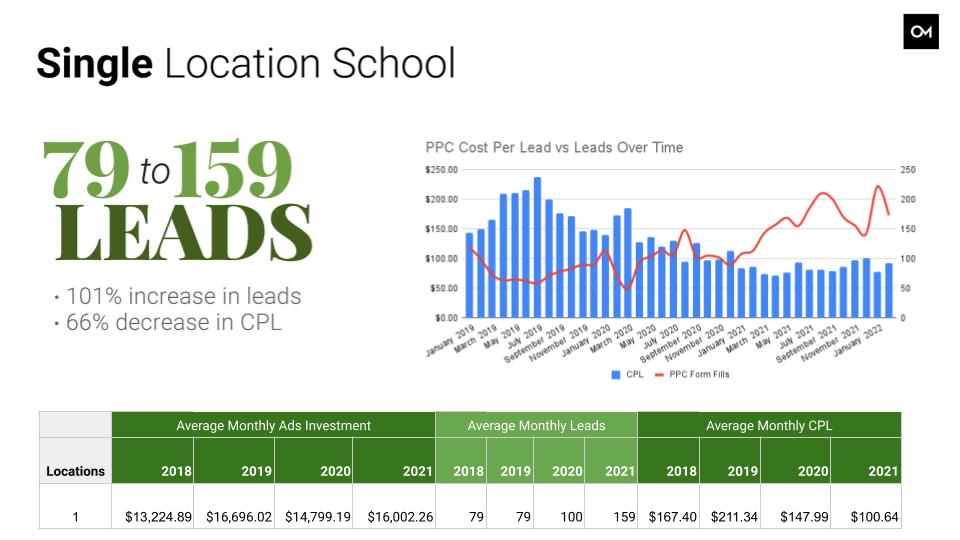
They’ve also benefited from constant and consistent iterations on their account, optimizations on their ad creative and their keyword performance. We’ve made updates to their landing pages over time and this again is week after week, month after month, year after year. Sort of a confession or spoiler alert, this is my favorite graph because it’s the smoothest.
You can see really incremental changes here and I just, I’m kind of a fan of graphs. So, bit of a nerd, but that’s what you want in your PPC agency.
Leads and Cost Per Lead for Clients Three and Four
Anyway, next example. These are actually two different schools. I put them on the same slide because as I dug into the information here, they really share a similar story so I put them side by side.
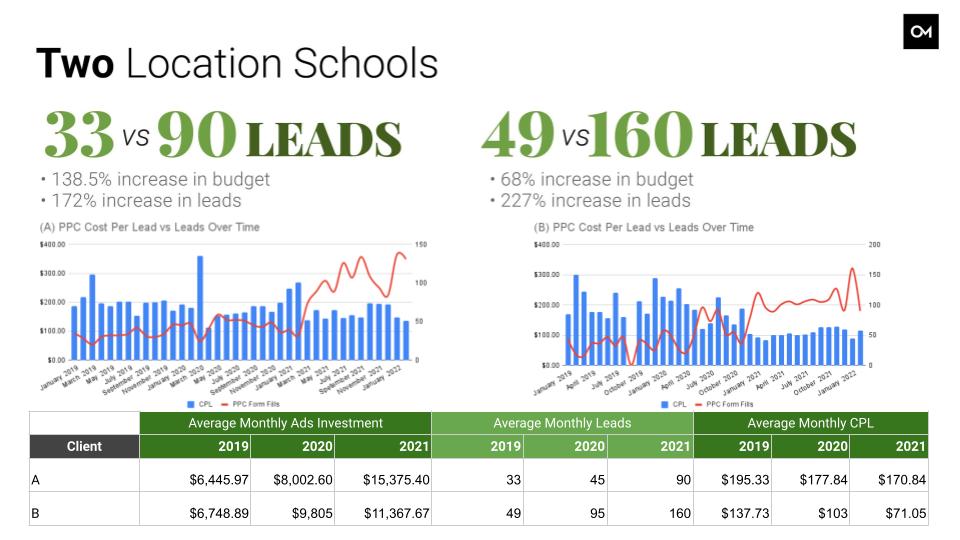
Each of these schools has two of their own locations. So, let’s take a look at the school on the left first. Initially the school was focusing a lot on their cosmetology leads, but it wasn’t really getting them the success that they wanted. They weren’t seeing a lot of results from that because it wasn’t really in demand in their market. That strategy was effectively shutting the door on other leads for other programs that they had because their budget was all tied up in those cosmetology leads.
So, as I mentioned, they weren’t really super happy with it. We talked about it, suggested a strategy change of focusing on the broader market demands. In this case that would be skincare, barbering, nails, etc. And once we did that, we saw the overall number of leads increase. The historical data that we had from months of working on the account before and the collaboration and trust that the client had with us was what made room for us to make these changes.
They maintained regular calls with us. They see a massive jump in leads, a drop in cost per lead. That was a 138% increase in budget that we ended up seeing, but 172% increase in leads.
The leads increased at a rate that outpaced their budget increase, so they’re still getting a lower cost per lead on average. And at the end of the day, they still enrolled more cosmetology students, the ones that they were looking for originally. So, that’s a pretty impressive story.
School B, let’s look at the one on the right. Like I mentioned, it was really similar to the one on the left. They had recently opened a new location, but they were frustrated with the performance of that for the same reason, they were focusing on a program that was not really the best fit for their audience.
We used some of the data that we had gathered, decided to shift our strategy a little bit towards barbering because in that market that’s what was getting the most demand. We restructured the account. We ran campaigns for barbering towards program-specific landing pages. We added even upper funnel tactics like display and YouTube specifically targeted around the barbering program. Then they saw, you can see here, a pretty significant change in leads and a decrease in cost per lead.
So in this case they increased their budget by 68% and saw a 227% increase in leads. Again, the increase in leads is way outpacing the increase in budget, which is really what you want to see.
All Schools Are Different
Just a side note, I like comparing these two because even though they share a similar story, the numbers are different and that’s just what you’re going to see.
Schools are different, programs are different, markets are different, locations are different so the results aren’t always going to be the same. But, it does share a similar story and in that it shows to me that through data collaboration, focusing on the right programs, we’re able to see a sudden and dramatic shift in performance. Ultimately, they benefited from that.
Leads and Cost Per Lead for Client Five
We got one more school to look at here and with this last one, just keep in mind, if you haven’t noticed already some of the patterns that I’ve noticed or that I’ve mentioned. Keep those in mind as we look through this last one.
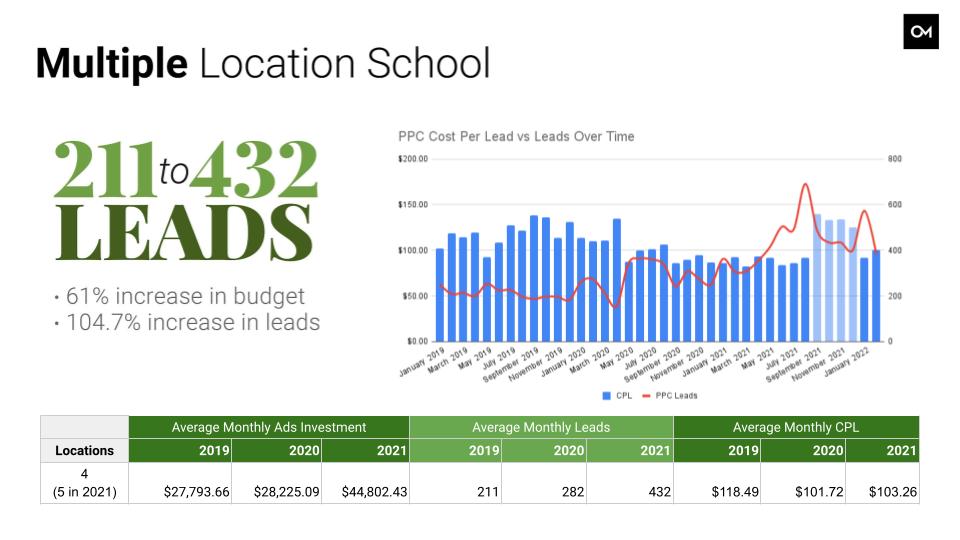
This one comes with a bit of a caveat though, this one’s a little bit harder to interpret because this school was the victim of a spam clicks attack. They got, over the course of a few months at the end of 2021, an increase in clicks that weren’t real people.
That drove their costs up a little bit without resulting in any conversions or leads, and that’s just one of the risks you run when you do business on the internet, that’s just part of the game. But we were able to work through it with them as best we could, and still overall, they saw with their increase in budget, 60% increase in budget, 104%, almost a 105% increase in leads.
So, how did they achieve this? Well, similar to all the stories we’ve been saying so far, they were getting continuous account optimizations. We were tweaking their account incrementally over time. We created program-specific landing pages. We added display and YouTube ads to increase their audience size, to increase their brand awareness. We restructured their account at one point to improve performance and then in the last year, in 2021, they actually added a fifth location. So they went from four locations to five.
We started that out with some brand awareness tactics because we had already built some of those audiences and we knew what that demographic looked like. Then, we noticed that a lot of their campaigns were being limited by budget, so again, we worked together to decide to increase that budget quite substantially. You’ll notice that from 2020 to 2021 it jumped the most because the goal was to see how many additional leads we can bring in and not hit that point of diminishing returns where the cost per lead starts to go up.
In this case, you can see we still haven’t even quite hit that because the cost per lead overall is lower than it was before. So again, this is another great example of using historical data and collaborating with your agency, along with incremental tweaks over time to continuously improve and grow your business, to create a long term and continuously improving PPC strategy.
Common Keys To Success For These Schools
Okay, so the analysis. After having looked at these different schools, I think that they share three common things that led to their success:
- Collaboration with their agency
- Consistent and incremental changes
- Longevity with a specialized agency
I want to talk about each of those individually for just a moment.
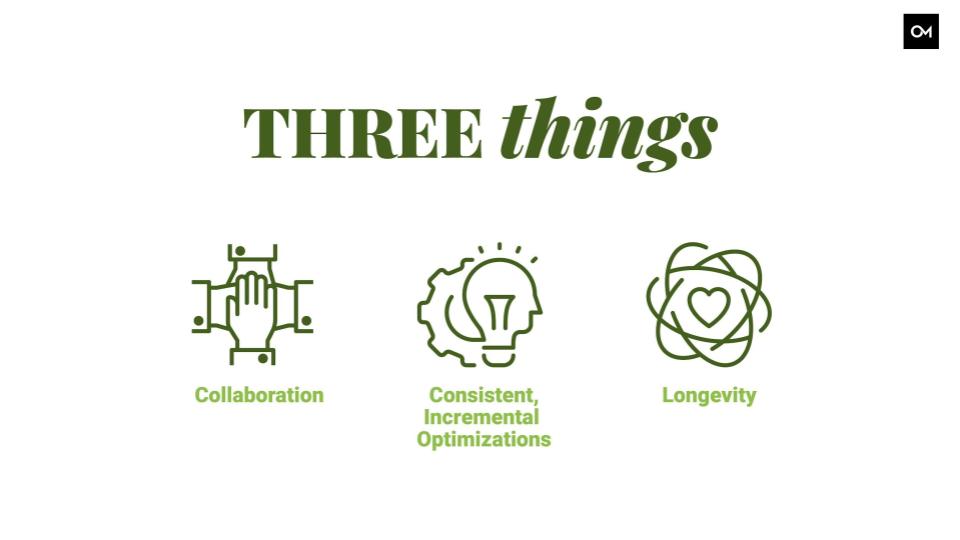
Collaboration With Their Agency
When it comes to collaboration, I think there’s a spectrum. There’s essentially three categories of client types. There’s on the one end the “do it for me” client, those who know that it needs to be done, but they don’t want to have to do it themselves or think about it at all. They just tell you to go do it for them.
On the other end of that spectrum is the people who know that they really can’t do it by themselves, but they want to control and manage as much of it as possible.
Then, in my opinion, the sweet spot is in the middle where there’s a client-agency relationship where there’s trust and collaboration. The client can trust in the expertise of their agency and help provide the goals and work together.
Consistent and Incremental Changes
When it comes to consistent and incremental optimizations, I think this is on the agency. This is a nod to the “lead bullets” approach rather than a “silver bullet” approach. We know that silver bullets don’t really exist and that really what works is tried and true tactics over time, putting in a little bit of elbow grease, and making sure that you’re consistently monitoring and checking in and optimizing your account.
Longevity With a Specialized Agency
Then lastly, longevity with a specialized agency. I know that it’s kind of a thing for businesses to test out an agency for six months at a time or a few months here and there and jump from one to the next until they find what you want.
I think there’s some merit to this because there are bad marketers out there who are doing the wrong things. So, if you find yourself in a situation where your agency is doing it badly, then you know, don’t hesitate to jump ship and look elsewhere. But, take it from me that collecting useful data for your PPC campaigns can take time. Especially if you’re in a business that has seasonal fluctuations, you can consider the whole calendar year as a sample size of basically one. So it takes a long time and a lot of data to get the information you need to make adjustments that make sense.
That’s where a specialized agency can make up some of that gap. If they’re familiar with your industry, they can apply what they’ve learned with their other clients to your account and your campaigns, and you don’t have to wait quite as long to make those appropriate adjustments. As I mentioned before, that being said, there’s differences in every market so there will be some learning curve, but a specialized agency will be able to help you get through that learning curve much more quickly.
Inspect What You Expect
So, inspect what you expect. This is something that we say a lot here at Oozle and that’s what I want to encourage you to do right now, after we’ve talked about these different things.
- Are you working together with your agency?
- Are you seeing regular and consistent work being done on your campaigns?
- Are you giving it the time that it deserves?
If that’s all happening right now with your PPC strategy, great. Keep it up. You’re headed in the right direction. You’re doing the right things.
On the other hand, if you’re not having monthly reports or communication with your agency or you’re not seeing an actual impact on your leads, then maybe it’s a sign that it’s time to look elsewhere, maybe at an agency that has a specialty in your industry. And just as a reminder, none of this happens in a vacuum. We’ve been looking here at PPC tactics and PPC results, but in all of these cases, these schools are also doing other things like organic marketing or paid social advertising.
Everything you do out there has an effect of its own and impacts your overall business. This is just one piece of the puzzle, but I think it’s an important piece, and hopefully we’ve seen how it can improve over time if you give it what it needs.
So, thank you. I appreciate your time and attention. If you feel like you maybe aren’t on track with your PPC leads, I think there will be a link here in the chat to a little survey in which you can, I think we’re going to publish the responses here so you can see how you compare, and then let us know if you want to talk about it a little further. Here’s my email address. If you want to get in touch with me, I’m happy to talk anything PPC or give you an account audit or anything like that. But yeah, thanks again for tuning in to the session. I hope it has been helpful.
